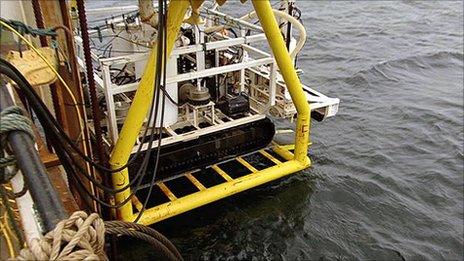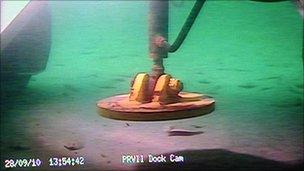At sea with the particle hunters
- Published

The ROV being lowered into the sea from the barge LM Constructor
BBC Scotland reporter Craig Anderson joined a team recovering radioactive particles flushed into the sea from the Dounreay nuclear site on the Caithness coast.
It is the £800,000 underwater robot that's cleaning up the seabed around the Dounreay nuclear plant.
I had expected to be met with something like a cute yellow submarine but this remotely operated vehicle (ROV) is far from that.
The purpose-built buggy runs on caterpillar tracks over the seabed beneath the Pentland Firth and bristles with high-tech cameras, lights, locator devices and the all-important radiation detectors.
All of this crammed into a steel frame the size of a small van.
The task of the ROV and the 20 crew who live aboard the mothership barge, the LM Constructor, is to scour the seabed for radioactive hot spots and retrieve them.
Much of the technology is derived from the North Sea oil industry and this is a round-the-clock exercise, according to marine supervisor Dave Brierley.
He said: "The machine travels in straight lines up and down the seabed.
"Once you've detected a particle we locate the auger over the front of it and we turn the pumps on and that pumps all the sand including the particle up and into the tanks on the back."
The particles of Caesium 137 are filings from nuclear fuel rods reprocessed at Dounreay during the 1960s and 1970s.
Flushed into the sea through the plant's liquid discharge pipe, they have been turning up on local beaches for nearly three decades.
This seabed clean-up campaign is costing millions of pounds - all to rectify the nuclear mistakes of the past.
Abandoned project
Bill Thomson, from Dounreay Site Restoration Limited (DSRL), is in charge of the entire clean-up operation. He said: "It was historical operations that were figured to be perfectly acceptable at the time when they were done.
"Things change, we find these things, we decided we needed to do something about it.
"The public decided we needed to do something about it, so fine, that's what we do."
As I watched in the control room, another particle was discovered. A small one, apparently.

An image from the seabed taken by a camera on the ROV
That made 255 hot spots found and recovered within the past two months.
The ferocious weather and sea conditions of the Pentland Firth limit the time available for the retrieval process.
Since starting the search two months ago the team have had to run for shelter a number of times and with the weather closing in, the operation is about to shut down until next summer.
But with more than 40 hectares (100 acres) of the seabed still to survey, the barge and ROV will be back again early next summer.
Onshore, decommissioning work continues and eventually the entire Dounreay site will be levelled.
Not even the iconic dome will be left, even though there have been calls for the steel golf ball to be listed as a historic building.
Nuclear experts say the radiation risk is too great to allow public access for the next 300 years.
The seabed work this year has already cost £1.5m, not including the cost of the ROV and while some insist Britain's world-beating nuclear fast reactor programme was a success in scientific terms, dealing with the legacy of the abandoned project is now costing far more than its pioneers ever imagined.
- Published30 September 2010